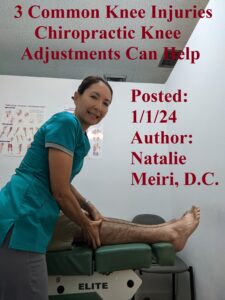
When thinking of chiropractic, people always think it’s only for the spine. Moreover, the question people ask often is, “can a chiropractor adjust knees?” The answer is, yes. In fact, it is an effective natural treatment option for those suffering from many conditions leading to knee pain. Chiropractic adjustments can help with knee pain by improving joint function, thereby providing relief.
Is knee pain affecting your life and causing discomfort and limiting mobility? In this post we will explore 3 Common Knee Injuries Chiropractic Knee Adjustments Can Help.
1. Knee Meniscus Tears
The knee meniscus is the rubbery knee cartilage that cushions the tibia (shinbone) from the femur (thighbone).
You may have knee pain usually following a rotational injury to the knee. Next, there may be swelling in your knee that developed over a number of hours. And since the injury, you may have episodes of knee locking wherein you experience significant pain. Also, you may not be able to move the leg for a few seconds until the injured knee is forcefully extended (straightened). Furthermore, you may complain of the knee “giving way”.
Imaging and Evaluation
There are examination (e.g. orthopedic/neurologic/chiropractic ) tests that have a positive finding for a meniscal tear. Of course, Meniscal Tears are seen on a magnetic resonance imaging (MRI). However, clinical correlation (results of the test should be interpreted in conjunction with the patient’s clinical symptoms, medical history, and other relevant diagnostic information) with MRI findings are important. This is because there may be other pathologies (cause of the disease) causing pain as well.
Cause of Meniscus Tears
Firstly, most meniscus injuries are due to combined compression with rotation at the knee. Secondly, there are many types of tears. They are generally divided into horizontal and vertical tears. Thirdly, because of the minor blood supply, meniscus tears do not bleed much into the joint. However, the free edge of the tear may cause irritation along with the synovial (thin membrane of joint) fluid production. Fourthly, the meniscus is often involved when the anterior cruciate ligament (ACL) is torn.

2. Popliteus Tendinitis
First, the popliteus muscle lies behind the knee joint. It forms the base of the popliteal fossa (diamond-shaped space behind the knee joint). Second, it inserts at the lateral femur, lateral meniscus and inserts onto the proximal (nearer to the center of the body) tibia (shin bone). Third, the popliteus muscle does lateral rotation of the femur relative to the tibia. And this ‘unlocks’ the knee joint so that the knee can flex (bend). Fourth, Popliteus is a major stabilizing muscle of the knee. Fifth, tendinitis is a condition in which the tissue connecting muscle to bone becomes inflamed.
You will have pain in the lateral (side away from body) knee following downhill running or walking. Your foot on the injured side may have hyperpronation problems.
3. ProximaI TibiaI-Fibular Chiropractic Subluxation (chiropractic intersegmental dysfunction/misalignment)
The tibial-fibular joint is formed by the tibia and the fibula (outer of the two bones between the knee and the ankle). The proximal tibial-fibular articulation is a synovial joint (freely movable joint). Synovial joints are the main functional joints of the body. Synovial joint cavities contain synovial fluid secreted by the synovial membrane (synovium), which lines the articular capsule.
Movement at this joint is influenced by movement at the ankle. Sudden forced movements (in particular dorsiflexion of ankle) may force the fibula into a fixed position. With hamstring curls, the biceps femoris (one of heads of hamstrings) may draw the fibular head posteriorly (back), leading to a chiropractic subluxation/misalignement. If left untreated, it may lead to entrapment of the peroneal nerve by the fibula. So compression or entrapment of the nerve may occur with the result of radiating pain down the outside lower leg.

3 Common Knee Injuries Chiropractic Knee Adjustments Can Help
The chiropractic approach to the treatment of knee injuries involves a thorough understanding of the anatomy, biomechanics, motor patterns, and kinetic chains of the lower extremity (limb), including the pelvis. Your kinetic chain is a combination of several successively arranged joints. These joints constitute a complex unit, as links in a chain.
By identifying the underlying problem or dysfunction, your chiropractor can implement a multilevel treatment protocol (detailed plan) that involves chiropractic manipulative therapy. A chiropractic realignment will restore faulty biomechanics. Lastly, your chiropractor can prescribe exercises to strengthen weakened muscle groups and motor pattern re-education.
At Meiri Chiropractic we provide chiropractic adjustments/ manipulation for your knee and any associated regions (e.g. foot, ankle, hip, pelvic or lumbar (low back) indicated. Additionally, soft tissue therapy (myofascial release, pressure point and various relaxation procedures) and modalities (cold/heat therapy and electric muscle stimulation) are rendered as necessary.
Do you know someone who needs Chiropractic adjustments for a knee injury? Contact Meiri Chiropractic serving West Palm Beach, Jupiter, North Palm Beach, and Palm Beach Gardens today at 561-253-8984 for this or some other ailment.
Video Vlog on same post